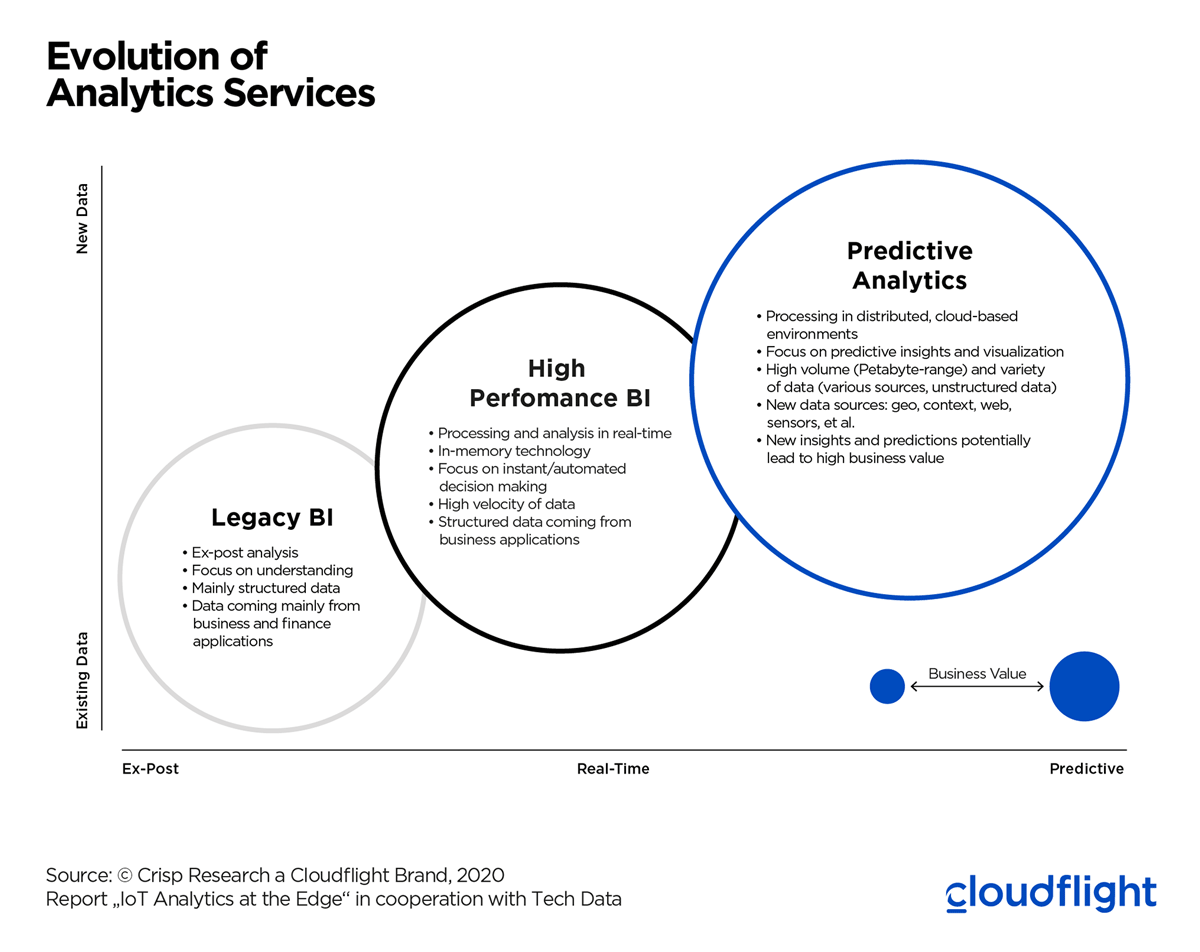IoT projects help companies find a way out of the crisis and ensure profitability
- For German SMEs, IoT (Internet of Things) business models rank among the key success factors.
- Networked products and software-based solutions are becoming the drivers of growth in many industries, and the development and operation of IoT solutions is thereby becoming the driver of digitisation in many places.
- Without a top-quality ecosystem that is made up, among other things, of strategic technology partners, cross-sector partnerships, varsities and start-ups, implementing IoT projects is next to impossible.
From Data Value to Data Business
After the past decade of data collection, so called “Big Data”, companies are in the midst of implementing digital and data-based business models. In recent years, many companies have successfully managed to launch IoT projects and also launch their first digital products into the market. However, due to both the coronavirus crisis and the automotive slump, the core business of numerous SMEs has suddenly become seriously threatened. Many companies are now ceasing their “digital experiments” to ensure profitability in their core business that has taken a hit. We, however, recommend switching from the “experiment” to focusing on sustainable digital business models as a second pillar and thus differentiating the core products on the market. Beyond that, companies should put in place a proper platform strategy to avoid incurring costs and to make digital projects profitable.
In the age of digitisation, data are the epitome of modern growth and the recipe for success. Those with (good and extensive) data can better understand their target market, adapt their product range appropriately, make production processes more efficient, and so much more. Entirely new potential is developing with data-driven business models, particularly in the context of the IoT. Networked products and software-based solutions are the drivers of growth, especially in the manufacturing industries. The development and operation of IoT solutions, the visualisation and processing of data thus become the drivers of digitisation.
What are the current trends surrounding data-based business models and IoT platforms? What role does a digital ecosystem play? These and other questions are what IT and digital decision-makers need to answer if they want to ultimately move from the IoT project to the IoT business model and to an IoT platform strategy.
Strategic trends in the IoT analytics sphere
A lot has happened since the topic of Big Data created a real sense of hype in 2010. A decade later, numerous companies have started consolidating their databases and preparing them for high-profile analysis options under the keyword “Big Data”. The networking of production facilities and products in the context of IoT currently leads to an enormous variety of data and creates completely new analysis and prognosis potential. The assignment workload as well as the spectrum of IoT application scenarios has expanded significantly within the company.
The potential for optimising business processes using data applications is consequently still immense − this large and fast market environment thrives above all from its multitude of technological successes and trends, e.g. Machine Learning and the “artificial” generation of knowledge and experience.
In process chains and IT architectures that are becoming increasingly complex, automation is also a good starting point for Machine Learning. Together, man and machine optimise company operations. With easy-to-use, cloud-based Machine Learning offers from the large-scale cloud providers, it is becoming far easier to process data on recommendations or predictions, even if you are not an expert, as the established cloud platforms also offer hybrid Machine Learning concepts that also allow for autonomous parts of the algorithm to be on Edge Devices.
Furthermore, Edge Computing ensures more efficient data transmission and local pre-processing and, for example, completely new applications to be generated through Cloud Native and analytics applications.
In addition, the topic of connectivity and transmission technology is an essential driver and plays a significant role for IoT scenarios. The new generation of 5G connectivity provides the highest operational performance of data transfer rates.
Beyond that, IoT services from the cloud ensure that companies can set up prototypes and Minimum Viable Products (MVP) much faster, as well as implement complex and hybrid IoT architectures and solutions.
Analytics & Machine Learning as instruments in a data-driven world
The development of Analytics Services shows which way the wind is blowing, particularly in the industrial sector. Many of today’s Big Data and analytics projects have an exploratory and innovative character and focus on predictive analysis (e.g. predictive maintenance) − many companies, however, are unable to cover this entirely with their current infrastructure.
Synergy effects through ecosystems
Another fundamental issue, besides the IoT product and the respective use of technology, is the ecosystem. Innovative companies in particular that have already advanced considerably in the context of IoT cannot evolve and develop in a vacuum. Rather, companies rely on different resources and varied platforms, technologies, processes, and standards to establish cooperative networks and create business models.
Companies that participate in and actively contribute to an IoT ecosystem thus become part of a network, which is so much more than the mere exchange of data. What forms from this are synergies that don’t just provide access to know-how and ideas for new business models; an ecosystem of this nature goes far beyond this and offers access to new market developments, from which new digital products and solutions result – the motto is “co-create the IoT-value”!
For companies that are already working on the development or expansion of their own IoT platform, the long-term question is about Make or Buy. Many technologies and protocols have been established, even standardised, in IoT, but the different processes and data are very individual.
Moreover, one does not just need a “server” decision, as most IoT infrastructures have data and parts of the applications in the cloud as well as in the company, and also locally “on the Edge” in the IoT device, in the vehicle, or in the building. Companies in Germany and Austria orchestrate operating concepts with IoT platform services from the cloud, commercially licensed software, Open-Source Frameworks, and on an entirely do-it-yourself basis. The result is that IoT architectures are different in every company and are never really identical.
Added value through partnering
For many companies, this leads to enormous challenges, as they can do a great deal right when conceptualising and implementing IoT solution and platform architecture, but they can also do a lot wrong. Therefore, it is logical that the evaluation and involvement of partners and service providers is one of the first and most important IoT initiatives when it comes to reflecting on your own strategy and ideas and ultimately being able to design and implement an IoT platform.
Aside from these new opportunities for partnering and technological trends, many IT and digital decision-makers still face considerable challenges, e.g. with the IoT operations and the interoperability of IoT platforms. The topic of Privacy & Data Ownership is another challenge − but, above all, the biggest challenge is how to guarantee comprehensive end-to-end IoT security.
Conclusion
For the bodies responsible for the digital aspect of the company, it is becoming increasingly more important to demonstrate the potential of IoT business models in their own companies and to explicitly implement Analytics & Machine Learning architectures.
It is imperative for almost every company to adapt its own IoT platform strategy to digital value creation. Companies may potentially also need two strategies, one for digital products and another for digital optimisation in production. For larger companies, this can also result in different platform decisions having to be made.
Recommendations for your IoT platform strategy:
- Don’t get into the topic of platforms too early. In the early phase of digital products, creativity and exploring the technical options are important. Different teams can work on this and the process should not be impeded by technological specifications.
- Promote IoT innovation. The first IoT projects should not be in competition with each other; rather, ideas and experiences with technology should be exchanged. The Chief Digital Officer (CDO) must establish the network between departments and teams.
- Moderate IoT business models. The biggest challenge is to match the technology and the business models. In many cases, technology initially enables a certain business model. Using Cloud Native technologies, for example, reduces operating costs, making viral go-to-market models possible. The CDO has to moderate here.
- Structure IoT use cases. A digital product is made up of different components − whereas a digital portfolio of a company is made up of different digital products. Portfolio management must be established for this purpose after the first experiments, which then also structures the requirements for a platform.
- Balance platform autonomy and platform synergies. As soon as you want to go live with an entire digital portfolio or a complex digital product, you should concentrate all your effort on a technology stack and a cloud backend. Regardless of the choice of a provider, the question arises of how much vendor lock-in you want. High-quality PaaS services in the cloud and commercially licensed software components on the Edge initially bring tempo to projects, but can later cost you a lot of money and result in long-term dependency on a provider.
- Adjust operations aspects to the volume. Compared to old enterprise IT, the cloud makes it possible to use many different and similar services. On the Edge, consolidation on fewer technology stacks still makes sense. If, when selecting the cloud services, you primarily choose Open-Source frameworks, you can use “fully managed” PaaS services to begin with. If the volume increases or you want to switch to a different cloud infrastructure, it is beneficial to operate these services yourself on the Kubernetes Container Management
- Use and develop skills. While IoT projects in most companies usually start with external assistance, you should make sure that, at the least, the parts that differentiate the digital product and implement their own intellectual property are soon covered by the company’s own developers. Even if skills are generally available through certain enterprise technology providers, CDOs and CIOs should not underestimate, and should instead encourage, the willingness to learn Cloud Native technologies.
The choice of technology also depends greatly on the requirements of the respective industry and the digital strategy of the company. External assistance should be sought, in particular when it comes to the evaluation of the technology. When choosing a service provider, it always helps to have a partnership of equals. Small companies often work better with medium-sized IoT service providers than with global service providers.
